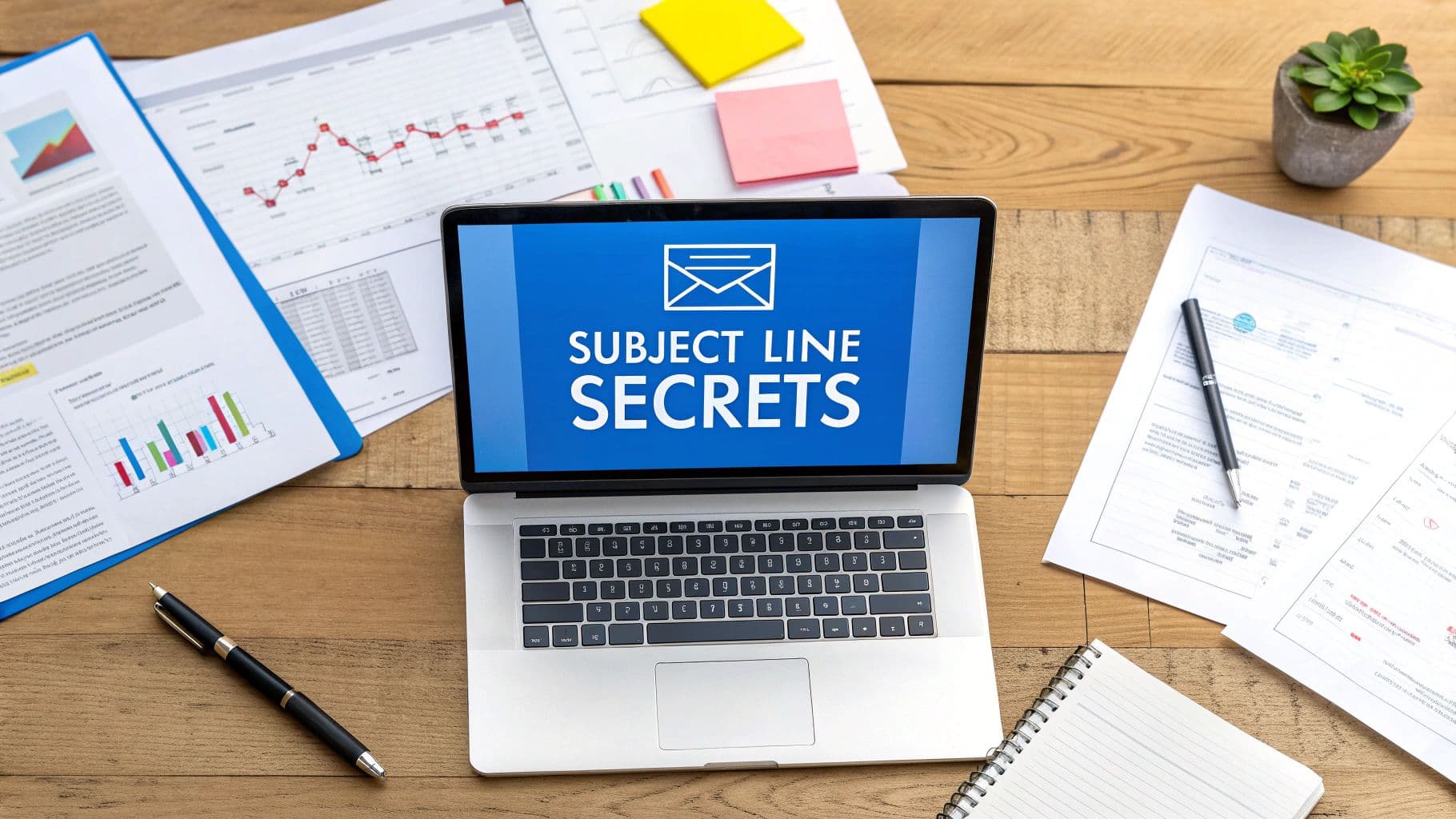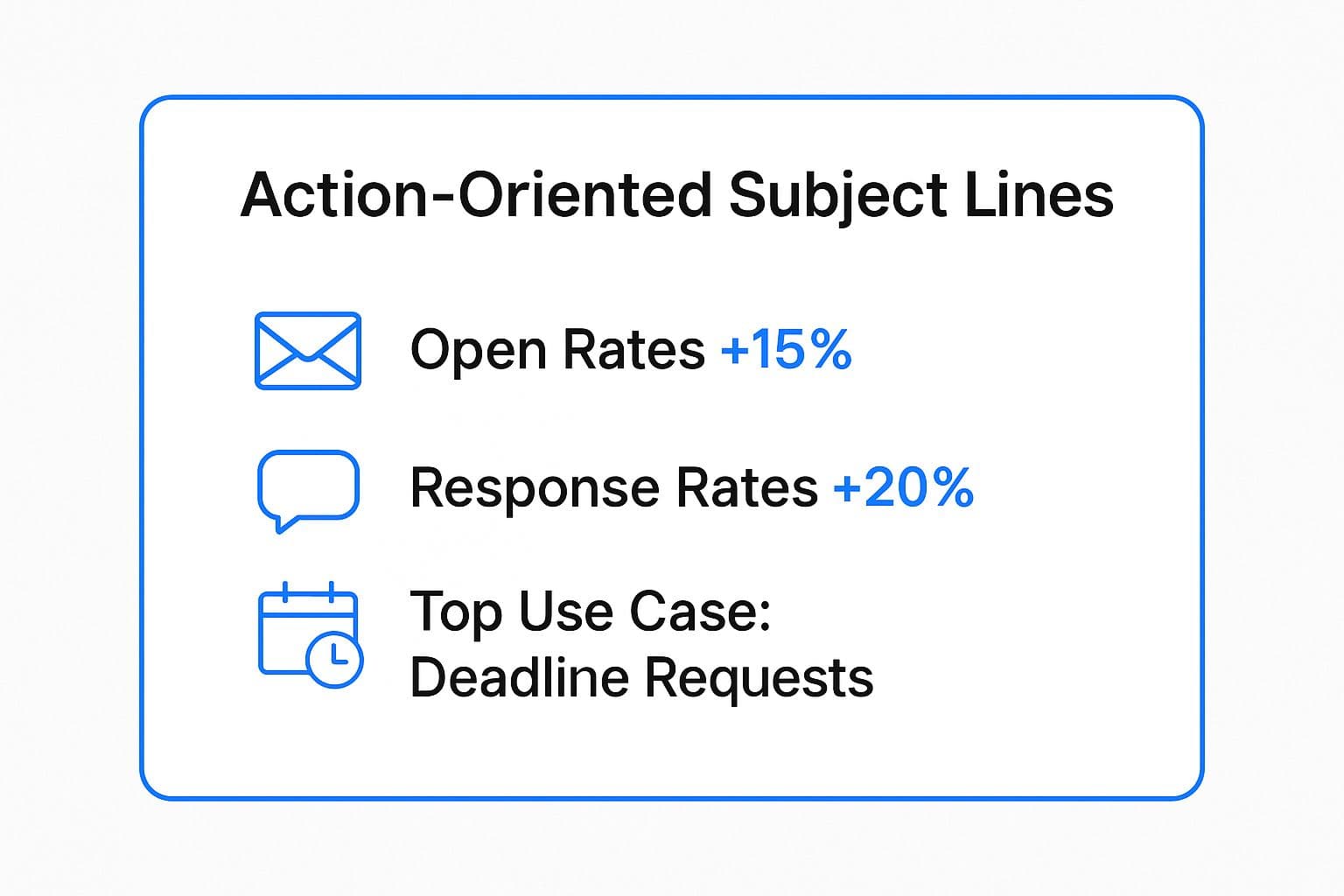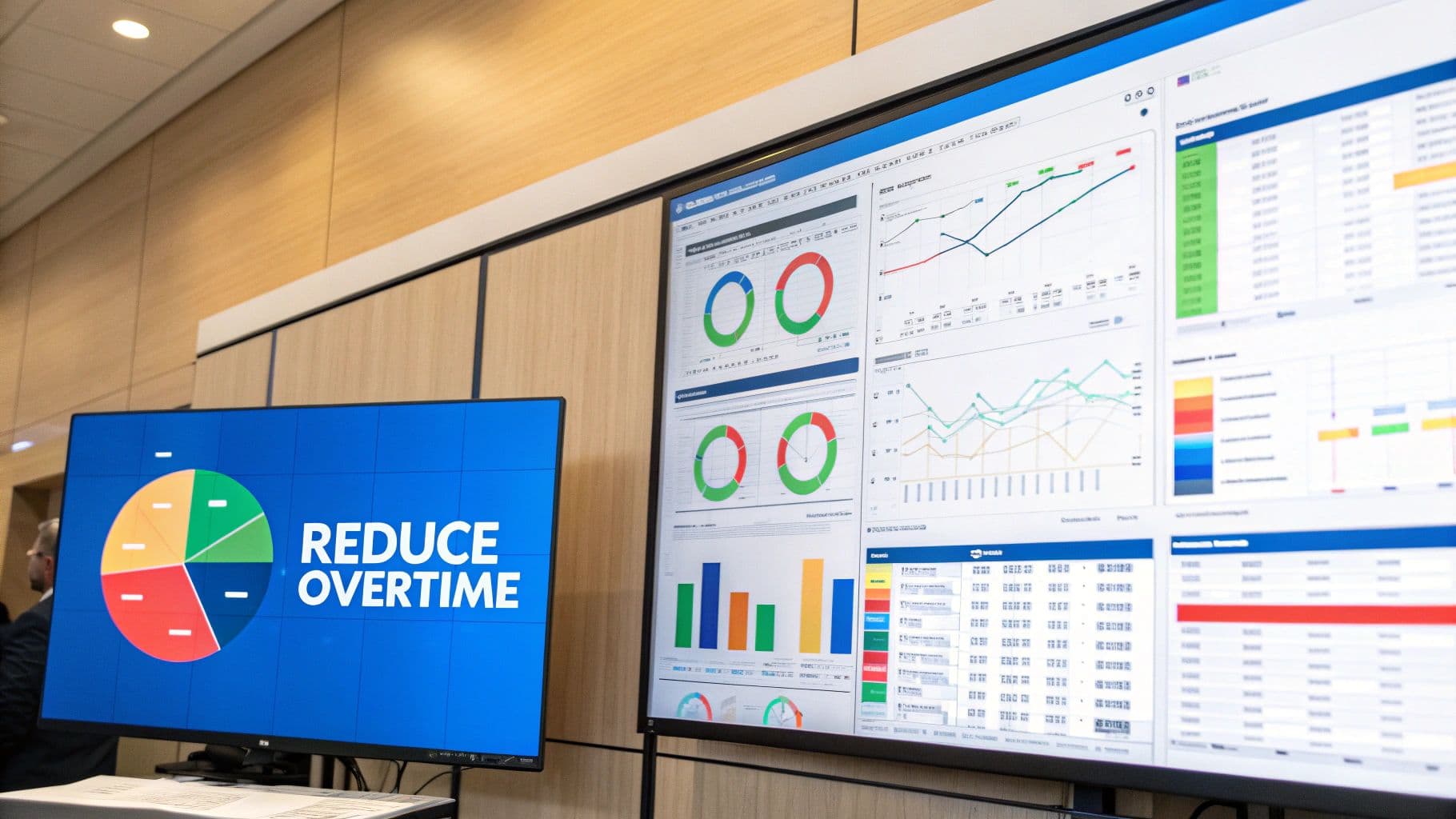7 Professional Email Subject Lines That Always Get Opened
Write professional email subject lines that get your emails read. Explore 7 examples and boost your open rates with these tips.

Stop Ignoring Your Subject Lines: Why They Matter
Your email subject line is the first impression. It determines whether your email gets opened or trashed. Think of it as a movie trailer – it has to be captivating. This listicle dives into 7 types of professional email subject lines that work. We'll analyze examples like a strategist, pulling out actionable tactics you can use.
Want to write subject lines that grab attention and boost your open rates? Then keep reading. We're covering these key subject line types:
- Action-Oriented
- Question-Based
- Benefit-Focused
- Personalized
- Urgency-Driven
- Collaboration-Focused
- Status Update
We'll explore what makes them effective, going beyond surface-level observations to give you replicable strategies. For more insights on related topics, check out the connectflux blog. By the end of this article, you’ll be crafting compelling professional email subject lines that get your emails read.
1. The Action-Oriented Subject Line
Action-oriented subject lines pack a punch. They start with a verb, telling the recipient exactly what you need them to do. This approach cuts through the noise of a busy inbox and makes it crystal clear what action is required. Think of it as giving your email a mini-mission statement. It's all about clarity and urgency, but in a polite and professional way.
Why Action-Oriented Subject Lines Work
These subject lines are effective because they leverage basic human psychology. People are drawn to clear instructions, especially when they're busy. An action-oriented subject line transforms a passive email into an active request, prompting a quicker response. Plus, it helps the recipient prioritize their inbox. They know immediately what's expected of them.
Examples of Action-Oriented Subject Lines
- Please review the Q3 budget proposal by Friday: This subject line clearly states the action (review), the item (Q3 budget proposal), and the deadline (Friday).
- Confirm your attendance at Monday's client meeting: This prompts a simple yes/no response and ensures everyone is on the same page.
- Submit your timesheet by 5 PM today: This creates a sense of urgency while providing a clear deadline.
- Approve the marketing campaign materials: This gets straight to the point, ideal for time-sensitive approvals.
Subject lines are crucial for getting emails opened; learn how to significantly improve email open rates courtesy of proven tips from DublinRush in 2024.
Tips for Crafting Effective Action-Oriented Subject Lines
- Use polite action words: "Please review" is more inviting than simply "Review."
- Include specific deadlines when possible: This adds urgency and helps with prioritization.
- Match the urgency level to the actual priority: Avoid overusing urgent language for non-urgent tasks.
- Be concise but complete: Get straight to the point, but provide enough information for context.
When to Use Action-Oriented Subject Lines
This strategy is particularly effective for:
- Requests requiring a specific action: Approvals, reviews, submissions, etc.
- Time-sensitive communication: Meeting reminders, deadline notifications, urgent updates.
- Emails where a clear call to action is essential: Event invitations, project updates, important announcements.
Key Takeaways: Action-Oriented Subject Lines
The following infographic visualizes key data points regarding the effectiveness of action-oriented subject lines in driving engagement and responses.

As you can see, action-oriented subject lines can significantly boost open and response rates, making them especially useful for deadline-driven communications. Learn more about crafting effective action-oriented subject lines. These professional email subject lines truly streamline communication and boost productivity. This method, popularized by corporate productivity consultants and project management professionals, deserves its place in any email strategy toolkit because it simplifies communication and encourages prompt action.
2. The Question-Based Subject Line
Question-based subject lines pique interest. They tap into our natural curiosity, prompting us to open the email and find the answer. This approach is particularly effective for sales, networking, and follow-up emails, transforming a passive email into an engaging conversation starter. Think of it as a friendly nudge, not a demanding request.
Why Question-Based Subject Lines Work
These subject lines work because they engage the recipient directly. A question requires an answer, even if it's just a mental one. This creates a sense of intrigue and encourages the recipient to open the email to satisfy their curiosity. It's a subtle yet powerful way to stand out in a crowded inbox.
Examples of Question-Based Subject Lines
- Are you available for a quick call this week?: This is a straightforward invitation that prompts the recipient to check their schedule.
- Would you be interested in reducing your software costs by 30%?: This question immediately highlights a potential benefit, making it hard to ignore.
- Can we discuss your marketing challenges?: This offers help and invites a conversation, a valuable approach for networking and sales.
- How did the product launch go?: This follow-up question shows genuine interest and encourages a response.
Tips for Crafting Effective Question-Based Subject Lines
- Make questions relevant and valuable to the recipient: The question should address their needs or interests.
- Avoid yes/no questions when possible: Open-ended questions encourage more thoughtful responses.
- Ensure the question relates directly to email content: The email body should provide the answer to the question posed in the subject line.
- Use sparingly to maintain impact: Overusing question-based subject lines can diminish their effectiveness.
When to Use Question-Based Subject Lines
This strategy is especially effective for:
- Sales and marketing emails: Intriguing questions can capture attention and generate leads.
- Networking emails: Questions can spark conversations and build relationships.
- Follow-up emails: Questions show continued interest and encourage further engagement.
- Surveys and feedback requests: Engaging questions can improve response rates.
Key Takeaways: Question-Based Subject Lines
Question-based subject lines can significantly increase open rates by appealing to the recipient’s curiosity. They work best when the questions are relevant, valuable, and directly related to the email’s content. This method, frequently used by sales professionals, marketing automation experts, and networking specialists, offers a compelling way to grab attention and encourage interaction. These professional email subject lines make your emails stand out from the rest and encourage engagement.
3. The Benefit-Focused Subject Line
Benefit-focused subject lines cut straight to the chase by highlighting the value proposition for the recipient. They answer the unspoken question every email recipient has: "What's in it for me?" This approach piques curiosity and encourages opens by focusing on the positive outcome the email offers. It's less about what you want and more about what the recipient gains.

Why Benefit-Focused Subject Lines Work
These subject lines tap into a fundamental principle of persuasion: focusing on the desired outcome. By highlighting the benefits upfront, you make the email more appealing and less like a demand on the recipient's time. It's a subtle but powerful way to increase open rates and engagement.
Examples of Benefit-Focused Subject Lines
- 5 ways to reduce your team's overtime costs: This promises practical advice and potential cost savings.
- Your new streamlined approval process is ready: This highlights improved efficiency and ease of use.
- Save 3 hours weekly with this reporting tool: This quantifies the time-saving benefit, making it highly attractive.
- Increase your conversion rates by 25%: This offers a tangible improvement in a key performance metric.
Tips for Crafting Effective Benefit-Focused Subject Lines
- Research recipient's pain points thoroughly: Tailor the benefit to their specific needs and challenges.
- Use specific numbers when possible: Quantifiable benefits are more compelling.
- Focus on outcomes, not features: Explain the "what" not just the "how."
- Ensure you can deliver on the promised benefit: Don't overpromise and underdeliver.
When to Use Benefit-Focused Subject Lines
This strategy is especially effective for:
- Introducing new tools or services: Highlight the value proposition upfront.
- Sharing helpful resources or information: Emphasize how the content will benefit the recipient.
- Promoting special offers or discounts: Clearly state the advantage for the recipient.
- Announcing improvements or updates: Focus on the positive impact of the changes.
Key Takeaways: Benefit-Focused Subject Lines
Benefit-focused subject lines provide an immediate incentive for recipients to open your email. By highlighting the value they'll receive, you make your communication more appealing and less intrusive. This method, widely used by digital marketing experts and SaaS companies, encourages engagement by directly addressing the recipient's needs and interests. This approach elevates professional email subject lines from mere notifications to opportunities for improvement and growth. It’s a powerful way to ensure your message stands out in a crowded inbox.
4. The Personalized Subject Line
Personalized subject lines cut through the digital clutter by speaking directly to the recipient. They leverage details like the recipient's name, company, recent achievements, or specific circumstances to create a sense of individual attention and relevance. This approach makes the email feel less like a mass-sent message and more like a tailored communication, instantly boosting its perceived value.
Why Personalized Subject Lines Work
Personalization taps into a fundamental human desire for recognition. Seeing your name or a reference to something relevant to you in a subject line immediately grabs your attention. It suggests the sender has taken the time to understand your context, making you more likely to open the email and engage with its content. It’s a simple but powerful way to build rapport and foster a connection, even before the recipient reads the email body.
Examples of Personalized Subject Lines
- John, congratulations on the TechCorp acquisition: This acknowledges a recent achievement, making the email feel timely and relevant.
- Sarah, your presentation at the marketing summit was excellent: This praises a specific accomplishment, creating a positive association with the sender.
- Following up on your LinkedIn post about remote work challenges: This demonstrates that the sender has engaged with the recipient's content, showing genuine interest.
- Microsoft partnership opportunity for your team: This highlights relevance to the recipient's company, suggesting a valuable proposition.
Tips for Crafting Effective Personalized Subject Lines
- Verify personal details for accuracy: Misspelling a name or referencing outdated information can backfire.
- Reference recent, relevant achievements or posts: This shows you're paying attention and adds value to the interaction.
- Avoid overly personal information: Keep the personalization professional and appropriate.
- Keep personalization professional: While friendly, maintain a business-appropriate tone.
When to Use Personalized Subject Lines
This strategy is highly effective for:
- Networking emails: Making a strong first impression with potential contacts.
- Sales outreach: Tailoring your message to specific prospects.
- Follow-up communications: Referencing previous conversations or interactions.
- Congratulatory messages: Acknowledging achievements or milestones.
Key Takeaways: Personalized Subject Lines
Personalized subject lines stand out in crowded inboxes. They demonstrate genuine interest and increase the likelihood of your email being opened. Learn more about crafting impactful subject lines with an AI writing assistant. This method, popularized by sales development representatives, executive recruiters, and business development professionals, offers a powerful way to forge connections and boost engagement with professional email subject lines. It emphasizes the recipient, not just the message.
5. The Urgency-Driven Subject Line
Urgency-driven subject lines are all about prompting immediate action. They create a sense of time sensitivity or importance, encouraging the recipient to open and respond quickly. These work by triggering the recipient's fear of missing out (FOMO) or their desire to address urgent matters promptly. This tactic can be highly effective, but it's essential to use it judiciously to avoid sounding like you're crying wolf.

Why Urgency-Driven Subject Lines Work
These subject lines tap into our natural tendency to prioritize tasks that appear time-sensitive. A well-crafted urgent subject line can cut through inbox clutter and grab the recipient's attention. It signals that the email requires immediate attention, increasing the likelihood of a quick response.
Examples of Urgency-Driven Subject Lines
- URGENT: Client presentation needs your input by 3 PM: This clearly states the urgency and the deadline.
- Last chance to register for tomorrow's webinar: This leverages FOMO to encourage immediate registration.
- Time-sensitive: Contract expires at midnight: This highlights the critical nature of the deadline.
- ASAP: CEO needs Q4 numbers for board meeting: This conveys the importance of the request and the need for a rapid response.
Tips for Crafting Effective Urgency-Driven Subject Lines
- Only use for genuinely urgent matters: Overusing this tactic will diminish its effectiveness.
- Include specific deadlines: This reinforces the sense of urgency.
- Explain why it's urgent: Providing context increases the recipient's understanding and motivation to act.
- Use sparingly to maintain credibility: Reserve urgent subject lines for truly time-sensitive situations.
When to Use Urgency-Driven Subject Lines
This strategy is most effective for:
- True emergencies or critical situations: When a rapid response is absolutely essential.
- Time-sensitive deadlines: Reminders for upcoming deadlines or expiring offers.
- Important requests from high-authority figures: Such as requests from a CEO or senior management.
Key Takeaways: Urgency-Driven Subject Lines
Urgency-driven subject lines can be powerful tools for getting your emails noticed and acted upon. However, use them wisely. Overuse can lead to recipients ignoring your emails, so reserve them for situations where genuine urgency exists. Learn more about The Urgency-Driven Subject Line and crafting impactful emails with AI assistance. This method, often employed by crisis management professionals, event coordinators, and legal professionals, offers a valuable way to ensure your important communications get the attention they deserve. Remember, professional email subject lines contribute to effective communication.
6. The Collaboration-Focused Subject Line
Collaboration-focused subject lines emphasize teamwork, partnership, and mutual benefit. They create a sense of working together toward common goals, fostering a more inviting tone than one-sided requests. These subject lines position the email as an opportunity for joint effort and shared success. Think of it as an invitation to a brainstorming session rather than a demand for action.
Why Collaboration-Focused Subject Lines Work
These subject lines resonate because they tap into the human desire for connection and shared accomplishment. People are more likely to engage with a message that positions them as a valued partner. This approach can be particularly effective in building stronger professional relationships and fostering a sense of community, even through email. Plus, it subtly implies that the recipient's input is valued and needed.
Examples of Collaboration-Focused Subject Lines
- Let's collaborate on the Johnson project proposal: This invites the recipient to participate actively in the proposal development.
- Partnership opportunity: combining our expertise: This hints at a mutually beneficial collaboration.
- Working together on the Q1 marketing strategy: This fosters a sense of shared ownership and responsibility.
- Joint solution for our mutual client: This highlights the collaborative nature of the effort and its benefit to a shared client.
Tips for Crafting Effective Collaboration-Focused Subject Lines
- Ensure genuine collaboration intent: The content of the email must reflect the collaborative spirit of the subject line.
- Be specific about partnership benefits: Highlight how the collaboration will benefit the recipient.
- Follow through on collaborative promises: Don't use collaboration as a guise for a one-sided request.
- Use inclusive language: Words like "we," "us," and "together" reinforce the collaborative message.
When to Use Collaboration-Focused Subject Lines
This strategy is especially effective for:
- Projects requiring joint effort: Proposals, brainstorming sessions, joint ventures.
- Building strategic partnerships: Networking, relationship building, alliance formation.
- Seeking input and feedback: Surveys, reviews, collaborative discussions.
- Situations where mutual benefit is key: Joint client projects, shared initiatives.
Key Takeaways: Collaboration-Focused Subject Lines
Collaboration-focused subject lines are a powerful tool for building stronger relationships, fostering engagement, and achieving shared goals. This method, often used by team leaders, partnership managers, and consultants, enhances communication by framing interactions as opportunities for mutual growth and success. They are an excellent choice for professional email subject lines when genuine collaboration is the goal.
7. The Status Update Subject Line
Status update subject lines clearly communicate the current state of projects, deliverables, or ongoing processes. They provide transparency and keep all stakeholders informed about progress, potential roadblocks, and planned next steps. These subject lines act as concise summaries, allowing recipients to quickly grasp the key information without opening the email. Think of them as progress reports delivered directly to the inbox.
Why Status Update Subject Lines Work
Status updates tap into the need for clear and consistent communication, especially in collaborative environments. They provide reassurance and build trust by demonstrating progress and accountability. These subject lines help recipients manage expectations and allocate their time effectively. Plus, they reduce the need for constant back-and-forth emails requesting updates.
Examples of Status Update Subject Lines
- Project Alpha: Week 3 progress update: This provides a clear project identifier and timeframe for the update.
- Website redesign: 75% complete, on schedule: This shows progress percentage and adherence to timelines.
- Q4 budget review: Pending your approval: This clearly indicates what action is required from the recipient.
- Client onboarding: Phase 2 completed: This marks a milestone achievement and suggests the next phase is imminent.
Tips for Crafting Effective Status Update Subject Lines
- Use consistent formatting: Establish a standard format to make updates easily recognizable.
- Include percentage complete when possible: This gives a visual representation of progress.
- Mention next steps or blockers: Briefly indicate what's coming next or any potential delays.
- Send at regular intervals: Establish a consistent update cadence to maintain momentum and transparency.
When to Use Status Update Subject Lines
This strategy is particularly effective for:
- Ongoing projects: Keep stakeholders informed of progress and any potential roadblocks.
- Multi-stage processes: Clearly mark milestones and transitions between phases.
- Tasks requiring input or approval: Indicate when items are pending review or action.
- Regular reporting: Provide consistent summaries of key metrics and performance indicators.
Key Takeaways: Status Update Subject Lines
Status update subject lines can significantly improve communication efficiency within teams and with clients. They promote transparency, manage expectations, and minimize the need for repetitive email exchanges. This method, popularized by project managers and Agile practitioners, is a valuable tool for anyone managing complex projects or processes. They streamline communications and ensure everyone is on the same page regarding progress. Using professional email subject lines such as these keeps things moving forward and encourages proactive engagement.
7 Styles of Professional Email Subject Lines Compared
| Subject Line Type | Implementation Complexity 🔄 | Resource Requirements 💡 | Expected Outcomes 📊 | Ideal Use Cases 💡 | Key Advantages ⭐ |
|---|---|---|---|---|---|
| The Action-Oriented Subject Line | Medium - requires tone calibration | Moderate - specific language and deadlines | ⭐⭐ High open + response rates | Deadline-driven requests, meetings, document reviews, decision requests | Clear call-to-action, urgency, professionalism |
| The Question-Based Subject Line | Medium - needs careful crafting | Moderate - relevance and creativity | ⭐⭐ High engagement, conversational tone | Sales outreach, follow-ups, networking, consultations | Engages curiosity, memorable, encourages dialogue |
| The Benefit-Focused Subject Line | Medium to High - needs research | High - understanding recipient needs | ⭐⭐ High open rates, builds trust | Product pitches, service offers, consulting, training | Clear value proposition, increased relevance |
| The Personalized Subject Line | High - time-intensive | High - thorough research | ⭐⭐⭐ Significantly higher open rates | Cold outreach, networking follow-ups, partnerships, recruitment | Builds rapport, stands out, professional |
| The Urgency-Driven Subject Line | Low to Medium - clear urgency needed | Moderate - accurate urgency info | ⭐⭐ High open and fast responses | Emergencies, last-minute requests, deadlines, critical updates | Drives immediate action, priority clarity |
| The Collaboration-Focused Subject Line | Medium - genuine intent necessary | Moderate - specific partnership details | ⭐ Medium engagement, relationship building | Cross-department projects, partnerships, team initiatives, joint ventures | Builds relationships, encourages cooperation |
| The Status Update Subject Line | Low - formulaic but consistent | Low - regular updates | ⭐ Medium consistency and accountability | Project updates, milestones, progress reports, status meetings | Transparency, reduces inquiries, accountability |
Level Up Your Email Game with TypeBoost
Crafting compelling professional email subject lines is no longer a game of chance. Throughout this article, we've dissected seven powerful subject line strategies: action-oriented, question-based, benefit-focused, personalized, urgency-driven, collaboration-focused, and the all-important status update. We've gone beyond simple examples, diving deep into the why behind their effectiveness, providing actionable takeaways you can implement immediately. Remember, your subject line is the first impression, the digital handshake that determines whether your email gets opened or buried alive in the inbox abyss.
Why Mastering Subject Lines Matters
Think about it: you could have the most brilliant email content in the world, but if your subject line falls flat, nobody will ever see it. For solopreneurs, indie hackers, freelance marketers, and anyone building a brand, this is a non-negotiable skill. Strong professional email subject lines directly translate to higher open rates, more engagement, and ultimately, better results. Whether you're pitching clients, nurturing leads, or collaborating with colleagues, a well-crafted subject line can be the difference between success and silence.
Key Takeaways for Powerful Subject Lines
Let's recap the core principles we've covered:
- Clarity is King: Avoid ambiguity. Make your purpose clear from the get-go.
- Personalization Pays: Tailor your subject lines to the recipient whenever possible.
- Benefits Drive Action: Focus on what the recipient gains by opening your email.
- Urgency (When Appropriate): Use sparingly, but effectively, to prompt timely responses.
- Testing is Essential: Experiment with different approaches to find what resonates with your audience.
Your Next Steps for Subject Line Success
Now that you're armed with these powerful strategies, it's time to put them into action. Don't just read and forget – actively integrate these techniques into your daily email workflow. Analyze your past emails. Which ones performed well? Which ones fell short? Identify areas for improvement and start experimenting. The more you practice, the better you'll become at crafting subject lines that grab attention and drive results.
Mastering professional email subject lines is an ongoing process. It's about continually refining your approach, adapting to your audience, and staying ahead of the curve. But what if there was a way to streamline this process, to make it faster, easier, and more efficient?
Ready to supercharge your email game and take your professional email subject lines to the next level? TypeBoost is your AI-powered secret weapon. Generate multiple subject line options instantly, test different approaches, and refine your messaging with personalized prompts. Stop wasting time agonizing over subject lines and start seeing real results. Visit TypeBoost today and discover the future of email communication.